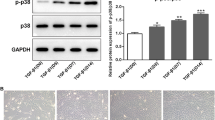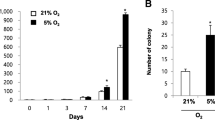Abstract
Apoptosis is an inevitable process during development and is evident in the formation of articular cartilage and endochondral ossification of growth plate. Mesenchymal stem cells (MSCs) can serve as alternative sources for cell therapy in focal chondral lesions or diffuse osteoarthritis. But there are few, if any, studies investigating apoptosis during chondrogenesis by MSCs. The aim of this study was to find the better condition to prevent apoptosis during chondrogenesis by MSCs. Apoptosis were evaluated in MSCs induced in different chondrogenic media by the use of Annexin V, TUNEL staining, lysosomal labeling with lysotracker and immunostaining of apoptotic markers. We found apparent apoptosis was demonstrated by Annexin V, TUNEL staining and lysosomal labeling during chondrogenesis. Meanwhile, the degree of apoptosis was related to the reagents of the defined chondrogenic medium. Adding serum in medium increased apoptosis, however, TGF-β1 inhibited apoptosis. The apoptosis was associated with the activation of caspase-3, the increase in the Bax/Bcl-2 ratio, the loss of lysosomal integrity, and the increase of PARP-cleavage. Pro-inflammatory cytokines, IL-1α, IL-1β and TNFα did not induce any increase in apoptosis. Interestingly, the inhibition of apoptosis by serum free medium supplemented with ITS was also associated with an increase in the expression of type II collagen, and a decrease in the expression of type X collagen, Runx2, and other osteogenic genes, while TGF-β1 increased the expression of Sox9, type II and type X collagen and decreased the expression of osteogenic genes. These data suggest apoptosis occurs during chondrogenesis by MSCs by cell death intrinsic pathway activation and this process may be modulated by culture conditions.





Similar content being viewed by others
References
Caplan AI (1991) Mesenchymal stem cells. J Orthop Res 9:641–650
Pittenger MF, Mackay AM, Beck SC et al (1999) Multilineage potential of adult human mesenchymal stem cells. Science 284:143–147
Sekiya I, Vuoristo JT, Larson BL, Prockop DJ (2002) In vitro cartilage formation by human adult stem cells from bone marrow stroma defines the sequence of cellular and molecular events during chondrogenesis. Proc Natl Acad Sci U S A 99:4397–4402
Johnstone B, Hering TM, Caplan AI, Goldberg VM, Yoo JU (1998) In vitro chondrogenesis of bone marrow-derived mesenchymal progenitor cells. Exp Cell Res 238:265–272
Mackay AM, Beck SC, Murphy JM, Barry FP, Chichester CO, Pittenger MF (1998) Chondrogenic differentiation of cultured human mesenchymal stem cells from marrow. Tissue Eng 4:415–428
Caplan AI, Stoolmiller AC (1973) Control of chondrogenic expression in mesodermal cells of embryonic chick limb. Proc Natl Acad Sci U S A 70:1713–1717
Denker AE, Nicoll SB, Tuan RS (1995) Formation of cartilage-like spheroids by micromass cultures of murine C3H10T1/2 cells upon treatment with transforming growth factor-beta 1. Differentiation 59:25–34
Tateishi K, Ando W, Higuchi C et al (2008) Comparison of human serum with fetal bovine serum for expansion and differentiation of human synovial MSC: potential feasibility for clinical applications. Cell Transplant 17:549–557
Gibson G, Lin DL, Roque M (1997) Apoptosis of terminally differentiated chondrocytes in culture. Exp Cell Res 233:372–382
Hashimoto S, Ochs RL, Komiya S, Lotz M (1998) Linkage of chondrocyte apoptosis and cartilage degradation in human osteoarthritis. Arthritis Rheum 41:1632–1638
Sharif M, Whitehouse A, Sharman P, Perry M, Adams M (2004) Increased apoptosis in human osteoarthritic cartilage corresponds to reduced cell density and expression of caspase-3. Arthritis Rheum 50:507–515
Blanco FJ, Guitian R, Vazquez-Martul E, de Toro FJ, Galdo F (1998) Osteoarthritis chondrocytes die by apoptosis. A possible pathway for osteoarthritis pathology. Arthritis Rheum 41:284–289
Gerber HP, Vu TH, Ryan AM, Kowalski J, Werb Z, Ferrara N (1999) VEGF couples hypertrophic cartilage remodeling, ossification and angiogenesis during endochondral bone formation. Nat Med 5:623–628
Zelzer E, Mamluk R, Ferrara N, Johnson RS, Schipani E, Olsen BR (2004) VEGFA is necessary for chondrocyte survival during bone development. Development 131:2161–2171
Hooiveld M, Roosendaal G, Wenting M, van den Berg M, Bijlsma J, Lafeber F (2003) Short-term exposure of cartilage to blood results in chondrocyte apoptosis. Am J Pathol 162:943–951
Hung SC, Chen NJ, Hsieh SL, Li H, Ma HL, Lo WH (2002) Isolation and characterization of size-sieved stem cells from human bone marrow. Stem Cells 20:249–258
Hung SC, Yang DM, Chang CF et al (2004) Immortalization without neoplastic transformation of human mesenchymal stem cells by transduction with HPV16 E6/E7 genes. Int J Cancer 110:313–319
Chang CH, Lin HY, Fang HW et al (2008) Chondrogenesis from immortalized human mesenchymal stem cells: comparison between collagen gel and pellet culture methods. Artif Organs 32:561–566
Chen WH, Lai MT, Wu AT et al (2009) In vitro stage-specific chondrogenesis of mesenchymal stem cells committed to chondrocytes. Arthritis Rheum 60:450–459
Tran TM, Temkin V, Shi B et al (2009) TNFalpha-induced macrophage death via caspase-dependent and independent pathways. Apoptosis 14:320–332
Chiou SH, Kao CL, Chen YW et al (2008) Identification of CD133-positive radioresistant cells in atypical teratoid/rhabdoid tumor. PLoS ONE 3:e2090
Lotz M, Hashimoto S, Kuhn K (1999) Mechanisms of chondrocyte apoptosis. Osteoarthritis Cartilage 7:389–391
Simonaro CM, Haskins ME, Schuchman EH (2001) Articular chondrocytes from animals with a dermatan sulfate storage disease undergo a high rate of apoptosis and release nitric oxide and inflammatory cytokines: a possible mechanism underlying degenerative joint disease in the mucopolysaccharidoses. Lab Invest 81:1319–1328
Pelletier JP, Jovanovic DV, Lascau-Coman V et al (2000) Selective inhibition of inducible nitric oxide synthase reduces progression of experimental osteoarthritis in vivo: possible link with the reduction in chondrocyte apoptosis and caspase 3 level. Arthritis Rheum 43:1290–1299
Takahashi T, Kitaoka K, Ogawa Y et al (2004) Lysosomal dysfunction on hydrogen peroxide-induced apoptosis of osteoarthritic chondrocytes. Int J Mol Med 14:197–200
Kuhn K, Hashimoto S, Lotz M (1999) Cell density modulates apoptosis in human articular chondrocytes. J Cell Physiol 180:439–447
Schuerwegh AJ, Dombrecht EJ, Stevens WJ, Van Offel JF, Bridts CH, De Clerck LS (2003) Influence of pro-inflammatory (IL-1 alpha, IL-6, TNF-alpha, IFN-gamma) and anti-inflammatory (IL-4) cytokines on chondrocyte function. Osteoarthritis Cartilage 11:681–687
Goldring MB (2000) The role of the chondrocyte in osteoarthritis. Arthritis Rheum 43:1916–1926
Westacott CI, Sharif M (1996) Cytokines in osteoarthritis: mediators or markers of joint destruction? Semin Arthritis Rheum 25:254–272
Kuettner KE (1992) Biochemistry of articular cartilage in health and disease. Clin Biochem 25:155–163
Maes C, Stockmans I, Moermans K et al (2004) Soluble VEGF isoforms are essential for establishing epiphyseal vascularization and regulating chondrocyte development and survival. J Clin Invest 113:188–199
Ashraf S, Walsh DA (2008) Angiogenesis in osteoarthritis. Curr Opin Rheumatol 20:573–580
Roosendaal G, TeKoppele JM, Vianen ME, van den Berg HM, Lafeber FP, Bijlsma JW (1999) Blood-induced joint damage: a canine in vivo study. Arthritis Rheum 42:1033–1039
Lopez-Armada MJ, Carames B, Lires-Dean M et al (2006) Cytokines, tumor necrosis factor-alpha and interleukin-1beta, differentially regulate apoptosis in osteoarthritis cultured human chondrocytes. Osteoarthritis Cartilage 14:660–669
Relic B, Bentires-Alj M, Ribbens C et al (2002) TNF-alpha protects human primary articular chondrocytes from nitric oxide-induced apoptosis via nuclear factor-kappaB. Lab Invest 82:1661–1672
Carames B, Lopez-Armada MJ, Cillero-Pastor B et al (2008) Differential effects of tumor necrosis factor-alpha and interleukin-1beta on cell death in human articular chondrocytes. Osteoarthritis Cartilage 16:715–722
Aizawa T, Kon T, Einhorn TA, Gerstenfeld LC (2001) Induction of apoptosis in chondrocytes by tumor necrosis factor-alpha. J Orthop Res 19:785–796
Yang X, Chen L, Xu X, Li C, Huang C, Deng CX (2001) TGF-beta/Smad3 signals repress chondrocyte hypertrophic differentiation and are required for maintaining articular cartilage. J Cell Biol 153:35–46
Buckland RA, Collinson JM, Graham E, Davidson DR, Hill RE (1998) Antagonistic effects of FGF4 on BMP induction of apoptosis and chondrogenesis in the chick limb bud. Mech Dev 71:143–150
Mello MA, Tuan RS (2006) Effects of TGF-beta1 and triiodothyronine on cartilage maturation: in vitro analysis using long-term high-density micromass cultures of chick embryonic limb mesenchymal cells. J Orthop Res 24:2095–2105
Freathy C, Brown DG, Roberts RA, Cain K (2000) Transforming growth factor-beta(1) induces apoptosis in rat FaO hepatoma cells via cytochrome c release and oligomerization of Apaf-1 to form a approximately 700-kd apoptosome caspase-processing complex. Hepatology 32:750–760
Lomo J, Blomhoff HK, Beiske K, Stokke T, Smeland EB (1995) TGF-beta 1 and cyclic AMP promote apoptosis in resting human B lymphocytes. J Immunol 154:1634–1643
Acknowledgments
Grants supported by Veterans General Hospital-Taipei (R92-001-6, Stem Cell Grant-supported by HealthBanks Biotech); National Science Council (94-2314-B-075-019; 97-2627-B-010-003) and National Yang-Ming University, Ministry of Education.
Conflict of interest
The authors have no conflict of interest to disclose with regard to the subject matter of this present manuscript.
Author information
Authors and Affiliations
Corresponding author
Additional information
Ling-Lan Chen and Pei-Yin Kuo are equal contributors.
Electronic supplementary material
Below is the link to the electronic supplementary material.
Rights and permissions
About this article
Cite this article
Wang, CY., Chen, LL., Kuo, PY. et al. Apoptosis in chondrogenesis of human mesenchymal stem cells: effect of serum and medium supplements. Apoptosis 15, 439–449 (2010). https://doi.org/10.1007/s10495-009-0431-x
Published:
Issue Date:
DOI: https://doi.org/10.1007/s10495-009-0431-x




